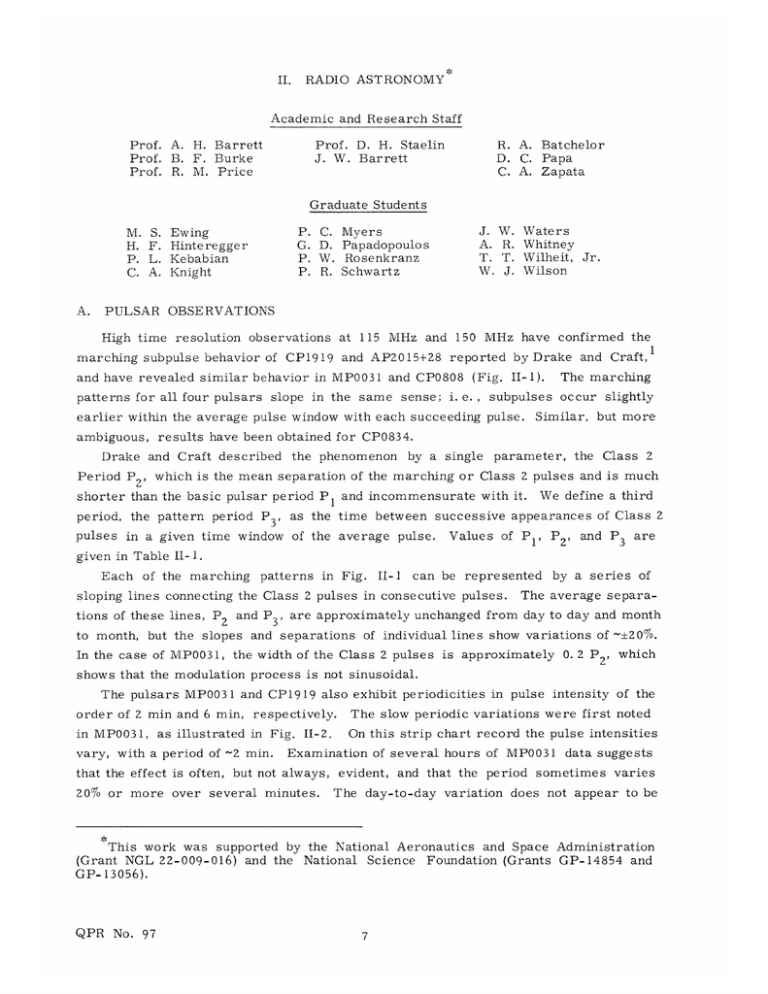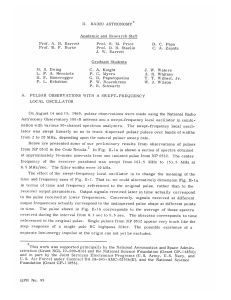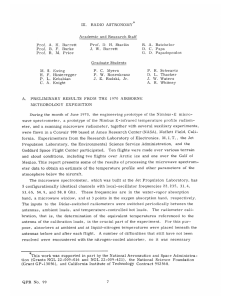II. RADIO ASTRONOMY Academic and Research Staff
advertisement

II.
RADIO ASTRONOMY
Academic and Research Staff
Prof. A. H. Barrett
Prof. B. F. Burke
Prof. R. M. Price
Prof. D. H. Staelin
J. W. Barrett
R. A. Batchelor
D. C. Papa
C. A. Zapata
Graduate Students
M. S.
H. F.
P. L.
C. A.
A.
J.
A.
T.
W.
P. C. Myers
G. D. Papadopoulos
P. W. Rosenkranz
P. R. Schwartz
Ewing
Hinteregger
Kebabian
Knight
W.
R.
T.
J.
Waters
Whitney
Wilheit, Jr.
Wilson
PULSAR OBSERVATIONS
High time resolution observations at 115 MHz and 150 MHz have confirmed the
marching subpulse behavior of CP1919 and AP2015+28 reported by Drake and Craft,I
The marching
and have revealed similar behavior in MP0031 and CP0808 (Fig. II-1).
patterns for all four pulsars slope in the same sense; i. e.,
subpulses occur slightly
earlier within the average pulse window with each succeeding pulse.
Similar, but more
ambiguous, results have been obtained for CP0834.
Drake and Craft described
the phenomenon
by a single
parameter, the Class 2
Period P2', which is the mean separation of the marching or Class 2 pulses and is much
shorter than the basic pulsar period P
period, the pattern period P 3 ,
1
and incommensurate with it.
We define a third
as the time between successive appearances of Class 2
pulses in a given time window of the average pulse.
Values of P',
P2,
and P
3
are
given in Table I-i.
Each of the marching
patterns in Fig.
II-1
can be represented
sloping lines connecting the Class 2 pulses in consecutive pulses.
by a series of
The average separa-
tions of these lines, P 2 and P3' are approximately unchanged from day to day and month
to month, but the slopes and separations of individual lines show variations of ~+20%.
In the case of MP0031,
the width of the Class 2 pulses is approximately 0. 2 P 2 , which
shows that the modulation process is not sinusoidal.
The pulsars MP0031 and CP1919 also exhibit periodicities in pulse intensity of the
order of 2 min and 6 min, respectively.
in MP0031,
as illustrated in Fig. 11-2.
vary, with a period of ~2 min.
The slow periodic variations were first noted
On this strip chart record the pulse intensities
Examination of several hours of MP0031
that the effect is often, but not always,
20% or more over several minutes.
data suggests
evident, and that the period sometimes varies
The day-to-day variation does not appear to be
This work was supported by the National Aeronautics and Space Administration
(Grant NGL 22-009-016) and the National Science Foundation (Grants GP-14854 and
GP- 13056).
QPR No. 97
~
I
60
I
sIx
'X9I999I9XX9
•
eX
(X
..
60
--
50
.xx.'
X#
"° •°XX
XIX.•XIX
**
.
*°
o•**
.X..
xx..
50
°
S40-
XX*
....
• *XIX
exx*..
-
XN#O X
S30
-
°
x *x99.
• 9#
•
:!N XX*X#I4!XX
•
z)
....
.xx...
*°
9
* *xxxf
40
K
*IXXXX
*
*XXXX
* ".xxlxx
9.
XXXX
. .
X X
*XXIXX
30
- ..i
xs
,
XI
.. ..
,,
a
9XX('
*X#I(III
I X•*X II
II*
XX! !X CXII
20
x
x
(a-
xxxxx x
.. :!!Xx- X,(:xxrX
~I
20
*XX*****
XX
X
I"
10
...
*XXX*X
. X...
°.•
100
50
0
TIME (MILLISECONDS)
,
••X
-- , "
**XXXX
-- ---
* * *
II
40
0
20
TIME (MILLISECONDS)
Fig. II- 1.
60
Systematic variations of pulse shape observed for (a) MP0031 and
(b) CP0808 on August 13, 1969. Each horizontal line represents
a time window centered approximately on the average pulse, and
successive windows are separated precisely by the pulsar period.
Relative
100 kHz.
QPR No. 97
(b)
p
intensities:
1 (.),
2 (X),
3 (#).
Filter-bank
resolution
Sweep ranges: (a) 155-151 MHz, (b) 151-143 MHz.
Table II-1.
Pulsar
Periodicities in pulsars.
P1
P2
P3
(s)
(ms)
(s)
0031
0.943
58
6.8
0808
1. 292
53
14.4
0834
1.274
110
1919
1. 337
15. 5
5. 9
2015
0.558
10.7*
2. 62
F. D. Drake and H. D. Craft, Jr.,
231 (1968).
Fig. II-2.
2.74
Nature 220,
Strip chart record of pulses from MP0031 recorded
at 158. 5 MHz (upper) and 112. 5 MHz (lower).
QPR No. 97
RADIO ASTRONOMY)
(II.
A suggestion of the short-term variation is evident in Fig. 11-2.
much greater.
periodicity is
The 2-min
also evident
in
pulse-intensity
spectra.
Four pulse-
observed at different times and at different frequencies,
intensity spectra of MP0031,
The spectra were computed by first extracting the strengths
are shown in Fig. 1I-3.
MP 0031
Fig.
11- 3.
00092 Hz
Pulse intensity spectra for MP0031
(upper four spectra),
and CP1919
(lower four spectra). Spectra illustrate the periodic behavior of pulse
bursts. Spectra were computed using
512 and 1024 pulses for MP0031 and
CP1919, respectively. The dates indicate when the data were recorded in
1969.
140 MHz 8/12
00051 Hz
CP 1919
230 MHz 11/10
0
00029 Hz
2
FREQUENCY
110 MHz
8/14
140 MHz
8/14
140 MHz
8/13
4 x 10
3
-2
Hz
of 512 consecutive pulses from 30-ms sampled data observed with a 50-channel radiometer.
The strengths of each of the 512 pulses were integrated
over bandwidths
of
either 1.5 MHz or 5.0 MHz, after the effects of dispersion were removed by a computer.
These 512 numbers were then Fourier-transformed
The spectra at 140,
of 196,
108,
142. 5,
to yield the illustrated spectra.
and 166 MHz peak at frequencies
and 137 s, respectively.
corresponding to periods
These variations in period appear to be a func-
tion of time rather than of observing frequency, and are compatible with those inferred
from the strip chart records.
Another
At 230 MHz the effect is generally less evident.
important feature of this new periodicity is also evident in Fig.
particularly in the upper trace,
recorded at 158. 8 MHz.
That is,
II-1,
the pulse-intensity
pattern which repeats at -2-min intervals is neither sinusoidal nor impulsive; rather,
QPR No.
97
n
(II.
RADIO ASTRONOMY)
it appears to be composed of more than one burst event, each event repeating at -2-min
intervals and each appearing or fading independently.
dominated by two events,
each of which survives -15
The upper trace appears to be
min.
Detection of the periodicity
is sometimes more difficult because the entire 2-min period is active, or at other times
because the period may vary more than 20%/ over many minutes.
A second pulsar exhibiting these properties is CP1919 for which 1024-pulse power
density spectra are shown in Fig. 11-3.
responds to a period of -345
s.
The spectra peak at -0.
0029 Hz, which cor-
In each case, two or three harmonics are also evident.
The harmonics apparently arise from the short duration of the individual burst events.
CP1919 is more stable than MP0031,
but is similar, in that the effect is less evident
Pulse strengths vary in a fashion similar to that for MP0031,
at 230 MHz.
or two excited regions are typically present,
each region
surviving
so that one
approximately
These excited regions may develop or fade either abruptly or slowly, and
20-30 min.
occasionally only an isolated burst is seen which does not repeat in the following cycle.
The repetitive appearance of pulse-intensity patterns with more than one excited
region supports the suggestion that some sort of waves are circulating about the pulsar
and modulating the pulse intensity.
Although such waves could conceivably reside on
the surface of the star, it is more likely that they are waves in the circumpulsar plasma,
and although they could circulate along a complex spatial trajectory, it seems more
likely that they would travel in an approximately circular orbit.
Each burst of pulses
then corresponds to a region of this circulating plasma ring which favors pulse emission. These enhancement regions survive approximately 10-20 min and may come or
By monitoring the waxing and waning of such regions it may be possible
go abruptly.
to learn something about the meteorology of the plasma envelope surrounding the star,
under the assumption that this plasma circulation model is correct.
One very interesting aspect of the long-period phenomenon is that it may be related
to the second periodicity discovered by Drake and Craft.I
One possible interpretation of the second-periodicity phenomenon is that those waves
circulating about the pulsar producing the long-period variations also have short-period
waves associated with them producing the short-term variations.
If the long-period and
short-period waves circulate about the star at the same angular velocities, then the long
period, designated P 4 , must be related to the other periods as
P
4
PP3
P
P22
This "period equation" predicts values of the circulation period of P4 of 111 s and 509 s
for MP0031 and CP1919, respectively, based on nonsimultaneous measurements of P
2
and P 3 (Sutton et al. 2). The predicted P 4 of 111 s for MP0031 is 32% less than the mean
of the representative periods evident in Fig.
QPR No. 97
II-2,that is,
196, 108, and 137 s, and the
(II.
RADIO ASTRONOMY)
predicted P4 of 509 s for CP1919 is 47% greater than the observed 345 s. A small
amount of data is available which permits P 2 , P 3 , and P4 to be measured simultaneously. On one occasion the predicted P 4 for MP0031 was 154 s, 36% more than the
observed value.
D. H. Staelin,
R. M.
Price, M.
R. A. Batchelor, J.
(Dr. John M. Sutton is with the National Radio Astronomy Observatory,
West Virginia.)
S. Ewing,
M.
Sutton
Greenbank,
References
1. F.
D. Drake and H. D.
Craft, Jr.,
2. J. M. Sutton, D. H. Staelin, R. M.
(1970).
QPR No.
97
Nature 220, 231 (1968).
Price, and R. Weimer,
Astrophys. J.
159, L89







